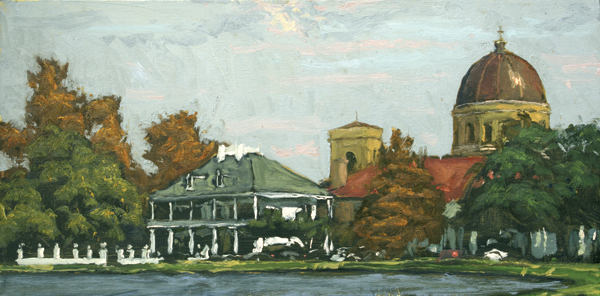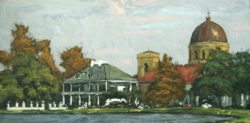Phil Sandusky
New Orleans artist Phil Sandusky describes his subject matter as "mundane" and "ordinary"–a shotgun house, cars parked on narrow streets, a sidewalk busy with shoppers.

Courtesy of Phil Sandusky
Bayou St. John. Sandusky, Phil (Artist)
The primary subject matter for New Orleans artist Phil Sandusky is, in his words, “mundane” and “ordinary” — a shotgun house, cars parked on narrow streets, a sidewalk busy with shoppers. “I have felt a calling to show people the beauty in the ordinary things they often take for granted,” he once wrote. “Also, when the subject is unremarkable, the seeing and painting dominate the work.” The devastation wreaked upon New Orleans by Hurricane Katrina in August 2005 caused Sandusky to temporarily diverge from this artistic course. He chose “to paint the most dramatic and horrific scenes of devastation because it’s my duty,” he said. “It’s my city. I don’t know if I will ever be able to observe and make a painting of a wood frame house again without being aware of how it would look if ravaged by the forces of nature, and how easy it is for that to happen.”
Sandusky was born in Lakeland, Florida, on August 16, 1957, As a child he loved painting as well as science and math. At Jacksonville University he majored in physics and took art classes to help improve his skills. At the time, the Pop Art movement was at its zenith, and there were few accepting havens for a fledgling artist who loved traditional academic realism. Between semesters and during summers, Sandusky studied painting at the Art Students League in New York City and took private lessons with Jacksonville artist Cleve Miller and the acclaimed Russian-born New York artist Robert Brackman. In 1980 Schlumberger Well Services hired the young physics graduate as an engineer to work on drilling platforms in the Gulf of Mexico off the Louisiana coast south of Lafayette. The company transferred him to New Orleans in 1984, where he met his soon-to-be-wife, Michelle, and began a dual career as an engineer and artist. Finally, in 1992 he made the choice between his right- and left-brain pursuits and became a full-time artist.
Before he came to New Orleans, Sandusky said his passions were portrait and figure painting, but after moving to the city, he explained, “I fell in love with its eclectic old architecture (in all stages of repair), its lush tropical foliage, its dense atmosphere, and not least of all its rich culture, which reveals itself here and there with subtle visual cues.”
Sandusky has always preferred working from life rather than from photographs. “The firsthand experience is infinitely richer than looking at a photograph,” he said. “Also working with live subjects makes you stronger as an artist. In this city, I’m probably the only painter who draws the hard line painting like I do working exclusively from life. I’ve lost a lot of money because of that but I don’t care. I know that working from life is the right thing to do. Marketing is secondary.”
The same philosophy underscores his paintings of the aftermath of Hurricane Katrina in New Orleans. “I didn’t think they would be marketable,” he said. “People asked why anyone would want to buy them.” In the months following the hurricane and widespread flooding of the city, Sandusky could be found daily roaming the most heavily damaged sections of the city, especially in the now fabled Lower Ninth Ward. There his palette turned from the mundane to the tragic —homes and lives destroyed, broken and twisted ruins of shotgun houses resting upon crushed vehicles, a hulking steel river barge marooned in a sea of debris that was once a living, thriving community. Sandusky’s plein air paintings are silent moments and immediate images of despair and uncertainty. In 2006, Sandusky claimed the storm greatly affected his life and art. “It blew away my sense of safe harbor and got me out there to do what I should be doing. I’ve lost my fear, for all could be gone tomorrow. You feel vital and alive when you don’t have safety nets.”
An admirer of Édouard Manet, Claude Monet, and John Singer Sargent, Sandusky hesitatingly describes himself as an impressionist painter. The term Impressionism, he says, was coined by a nineteenth-century writer who didn’t care for the emerging genre. If artists had named the movement, he claims they would have called it Perceptionism, for it appreciates the fleeting moment. “It’s the pinnacle of the art form that best reconciles how we see with art. It’s the ultimate of human visual perception. Each day is so incredibly different. Even the dog days of summer never seem to be the quite same. I like to seize that moment in my mind and paint it.”
Sandusky has built a considerable following for his unique style of painting. Art galleries in New Orleans, Atlanta, and Jacksonville, Florida represent him. His paintings can be found in corporate and private collections from New Orleans to New York City, including the New Orleans Museum of Art; The Historic New Orleans Collection; the Louisiana State Museum; the Beaches Museum in Jacksonville Beach, Florida; the Danforth Museum of Art in Framingham, Massachusetts; and the Whitney Bank and Ochsner Foundation Hospital, both in New Orleans. Sandusky has taught landscape and figure painting at the New Orleans Academy of Fine Art since 1994.
